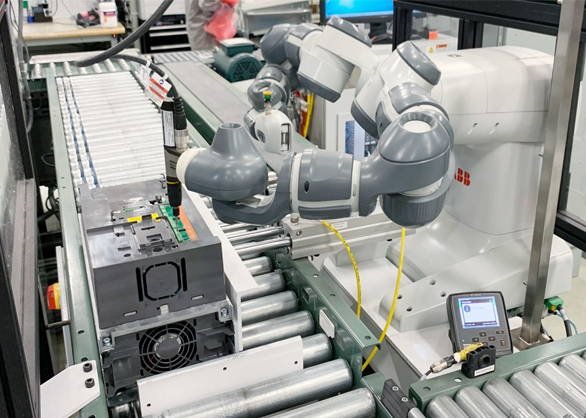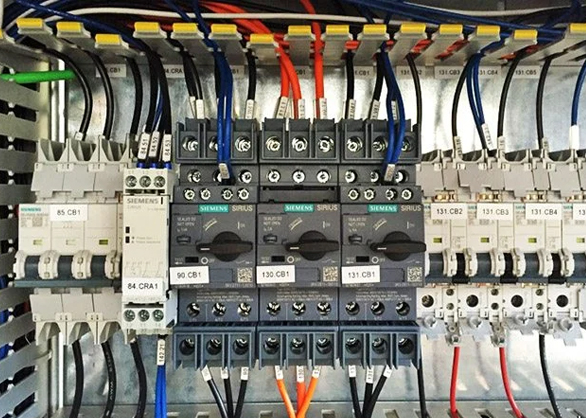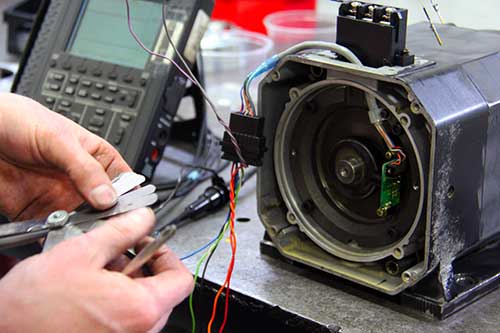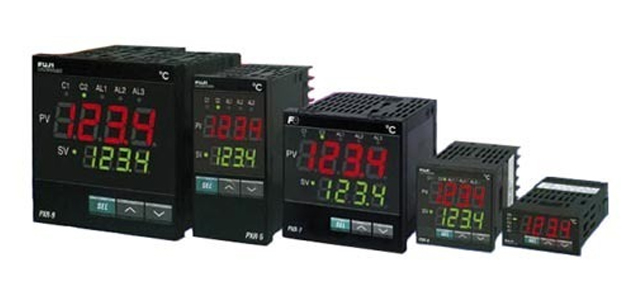For instance, in a heating system, if the temperature is below the setpoint, the controller will turn on the heating element to raise the temperature. Conversely, if the temperature is too high, it will stop the heating or activate a cooling mechanism. The goal ofis to minimize the difference between the actual temperature and the setpoint, ensuring that the system remains within the desired temperature range.
Advanced controllers, such as PID controllers, not only respond to the current temperature but also predict future temperature changes by calculating the rate of change (derivative) and the accumulated error (integral), allowing them to maintain stable control without overshooting or undershooting the setpoint.
4. Applications
they used in a wide range of industries to maintain product quality, ensure safety, and optimize energy efficiency. In the food and beverage industry, for example, precise temperature control is crucial during processes such as pasteurization, fermentation, and refrigeration, where deviations in temperature can affect product quality and safety.
In manufacturing, temperature controllers are employed in processes like plastic molding, metal heat treatment, and drying ovens to ensure that materials are processed at the correct temperatures for optimal strength, durability, and performance. In the chemical and pharmaceutical industries, help maintain the precise environmental conditions needed for chemical reactions and drug production.
Temperature controllers are also essential in HVAC (Heating, Ventilation, and Air Conditioning) systems, where they regulate the temperature in buildings, ensuring comfortable indoor climates while maximizing energy efficiency. In medical equipment, such as incubators or sterilizers, temperature control is critical to ensure proper functioning and safety in patient care.
5. Benefits
Energy Efficiency: One of the primary benefits of using is the improved energy efficiency they offer. By accurately regulating heating or cooling systems, temperature controllers reduce energy consumption by preventing systems from running unnecessarily. For instance, a well-calibrated temperature controller in a refrigeration system can minimize power usage while maintaining the desired temperature, leading to significant cost savings over time.
Product Quality: In many industries, maintaining consistent is essential for ensuring product quality. For example, in the food industry, fluctuating temperatures during storage or processing can lead to spoilage, contamination, or changes in taste and texture. Temperature controllers help prevent such issues by keeping the environment within strict temperature limits, thus preserving product integrity.
Safety and Reliability: improve safety by preventing overheating or freezing, which can damage equipment or create hazardous conditions.
In chemical processing or industrial heating systems, an uncontrolled rise in temperature can lead to dangerous reactions or equipment failures. Temperature controllers ensure that processes stay within safe operating limits, reducing the risk of accidents.
Reduced Maintenance: By preventing equipment from being overworked or exposed to extreme temperature variations, temperature controllers can extend the lifespan of heating, cooling, or ventilation systems. This leads to lower maintenance costs and fewer breakdowns, resulting in more reliable and continuous operation in industrial processes.
relevance in modern industries and daily applications cannot be overstated. These devices play a crucial role in ensuring operational efficiency, product quality, safety, and energy conservation across a wide range of fields. Here are some key aspects of their relevance:
1. Precision in Industrial Processes
In industrial manufacturing, temperature-sensitive processes are critical for producing high-quality products. For example, in plastic molding, metal heat treatment, or food processing, maintaining an accurate and consistent temperature is vital to achieving the desired material properties or product characteristics. Temperature controllers provide the precision required to keep these processes stable, ensuring that products meet strict specifications.
The relevance of is particularly evident in industries like pharmaceuticals and chemicals, where even small variations in temperature can lead to failed reactions or compromised product efficacy. By providing reliable and precise control, help manufacturers ensure that every batch meets regulatory standards and quality expectations.
2. Energy Efficiency and Cost Saving s are highly relevant to energy conservation initiatives in both industrial and domestic settings. By regulating heating and cooling systems efficiently, they help reduce unnecessary energy consumption. For instance, in HVAC systems used in buildings or industrial facilities, can optimize energy usage by maintaining the right climate without overworking the equipment.
Over time, the use of s can lead to significant cost savings by reducing energy bills and minimizing wear and tear on equipment. This energy-saving aspect is crucial for industries looking to improve their sustainability profiles and reduce their carbon footprints, making temperature controllers highly relevant in today’s energy-conscious world.
3. Ensuring Product Quality and Consistenc are essential for maintaining consistent product quality, especially in industries where temperature plays a direct role in the outcome of the process. In food and beverage production, for example, precise temperature control ensures that cooking, fermentation, and preservation processes occur within the ideal range, preventing spoilage and ensuring product safety.
In the electronics industry, are used in soldering processes where exact heat levels are required to avoid damaging delicate components. By maintaining the right temperature, these controllers ensure that every product meets the expected quality standards, reducing the likelihood of defects and improving overall production efficiency.
4. Safety in Critical Applications
These are highly relevant for safety in applications where temperature fluctuations can lead to hazardous situations. In chemical manufacturing or power plants, for instance, uncontrolled temperature rises can lead to dangerous reactions, equipment malfunctions, or explosions. help mitigate these risks by maintaining processes within safe operating temperatures.
In medical settings, is crucial for devices like incubators, sterilizers, and lab equipment, where patient safety and accurate results depend on stable temperature environments. Temperature controllers ensure these devices operate within safe limits, protecting both patients and healthcare workers.
5. Widespread Use Across Industries
extends across various industries, from large-scale industrial operations to small-scale domestic applications. In homes, for instance, temperature controllers are used in thermostats to regulate HVAC systems, ensuring comfortable living environments while minimizing energy use. In agriculture, manage conditions in greenhouses or livestock facilities to optimize growth and animal health.
In transportation, especially in the cold chain logistics industry, ensure that perishable goods like food and pharmaceuticals are stored and transported at the right temperature, maintaining product integrity throughout the supply chain. This widespread application highlights the importance of controllers in supporting critical functions in everyday life.
6. Support for Automation and Industry 4.0
As industries move toward automation and smart manufacturing (Industry 4.0), play a key role in integrated, real-time monitoring systems. Modern s are often connected to digital networks, allowing operators to monitor and adjust temperatures remotely. This connectivity ensures that processes can be automated, optimized, and monitored continuously for better efficiency and reduced human intervention.
In the context of Industry 4.0, help enhance the responsiveness of automated systems. By collecting and analyzing data from sensors, they can make quick adjustments to maintain ideal conditions, contributing to more agile, smart factories capable of adapting to changing demands.
In conclusion,s are highly relevant across multiple sectors due to their ability to provide precise control, improve energy efficiency, ensure safety, and enhance product quality. As industries focus more on automation, sustainability, and operational efficiency, the role of becomes even more critical in enabling modern, reliable, and efficient systems.
There are several myths surrounding , often based on misunderstandings about their functionality, applications, and benefits. Let’s debunk some common myths:
1. Myth: On/Off Controllers Are Inferior to PID Controllers
Reality: While PID (Proportional-Integral-Derivative) controllers offer more precise control, on/off controllers are not necessarily inferior. On/off controllers are simpler and are perfectly suited for many applications where precise temperature control is not critical. For example, in household appliances like water heaters or basic refrigeration units, an on/off controller is often sufficient. The choice between on/off and PID depends on the specific needs of the system.
2. Myth: All Are Complicated to Use
Reality: While some, especially PID controllers, may involve complex settings, not all are difficult to use. Many modern temperature controllers come with user-friendly interfaces and easy-to-read displays. Some are even plug-and-play, designed to automatically adjust to the environment. Additionally, advancements in technology have led to more intuitive designs that allow for simple configuration and use, even by non-experts.
3. Myth: Are Only Necessary for High-Precision Applications
Reality: are important not only for high-precision applications but also for basic processes where maintaining a stable temperature is key to safety, efficiency, and product quality. In everyday situations, such as HVAC systems, greenhouses, or food storage, maintaining consistent temperature levels through controllers ensures comfort, productivity, and quality. Even processes that don’t require precision can benefit from the efficiency and energy savings provided by basic .
4. Myth: Are Expensive and Not Cost-Effective
Reality: While advanced may have a higher upfront cost, they provide significant long-term savings by reducing energy consumption and preventing equipment damage. For instance, a well-calibrated temperature controller can minimize energy usage in heating or cooling systems, lowering energy bills over time. Additionally, by preventing overheating or overcooling, they help extend the life of equipment, reducing maintenance and replacement costs, making them cost-effective in the long run.
5. Myth: Once Installed, Don’t Need Regular Maintenance
Reality: Like any other piece of equipment, need regular monitoring and maintenance to ensure optimal performance. Over time, sensors can become less accurate, and settings might drift due to environmental factors. Periodic calibration is important to maintain the controller’s accuracy and efficiency. Neglecting regular maintenance can lead to performance degradation, reducing the controller’s effectiveness and potentially causing costly issues in the controlled system.
6. Myth: One Type of TSuits All Applications
Reality: There is no one-size-fits-all . Different applications require different types of controllers depending on the precision, range, and control needed. For example, a simple on/off controller might work for a basic heating system, but a PID controller is essential for processes requiring tight , like in chemical reactions or pharmaceutical manufacturing. Choosing the right type of controller depends on the specific requirements of the system, not a general assumption about what works best.
7. Myth: Instantly Fix Temperature Fluctuations
Reality: While help maintain stable temperatures, they don’t instantly fix fluctuations. Some processes have inherent lag times or other factors that can cause delays in reaching the desired temperature. Even with PID controllers, achieving the perfect balance takes time, as they make gradual adjustments to stabilize the system. Expecting immediate results can lead to improper adjustments and inefficiencies. Understanding the time it takes for the system to respond is crucial for effective use of temperature controllers.
8. Myth: s Are Only for Industrial Use
Reality are not limited to industrial settings. They are widely used in everyday applications such as home thermostats, ovens, refrigerators, and HVAC systems. In agriculture, they control temperatures in greenhouses, ensuring optimal growing conditions. In healthcare, they are used in medical equipment to regulate incubators or sterilizers. Their applications are broad, ranging from industrial machinery to everyday household devices.
9. Myth: You Can “Set and Forget”
Reality: Wh are designed to maintain temperature automatically, they still require monitoring and adjustment over time. Factors like sensor drift, environmental changes, or system wear can affect performance. Regular checks ensure the controller is working correctly and that the system’s efficiency is maintained. A “set and forget” mentality can lead to suboptimal performance or even system failure in the long run.
10. Myth: More Expensive Always Perform Better
Reality: The performance of a depends on its suitability for the specific application, not just its price. A more expensive controller with advanced features, such as complex PID algorithms, might be overkill for a basic application. Conversely, a cheaper controller that matches the needs of the process could perform perfectly well. Selecting a controller should be based on the system’s requirements rather than assuming a higher price guarantees better performance.
In summaryare versatile tools, but many myths persist around their complexity, cost, and applicability. By understanding their true capabilities and limitations, users can make more informed decisions and optimize their systems more effectively.
The effectiveness of is evident in their ability to maintain precise temperature regulation, optimize processes, improve efficiency, and ensure safety across various applications. Below are key factors that demonstrate the effectiveness
:
1. Precision and Accuracy are highly effective at maintaining a stable and accurate temperature in industrial and household processes. This precision is critical in industries such as pharmaceuticals, food production, and chemical manufacturing, where even slight temperature fluctuations can affect product quality or safety.
In systems using PID (Proportional-Integral-Derivative) controllers, the effectiveness is seen in their ability to respond dynamically to changes, making incremental adjustments to keep temperatures within a set range. This minimizes overshooting or undershooting the desired temperature, ensuring consistency and reducing waste or defects in production.
2. Energy Efficiency
contribute to energy savings by preventing systems from overheating or overcooling. This is especially true in HVAC systems, industrial furnaces, and refrigeration units, where precise temperature control ensures that equipment runs only when necessary, thus reducing energy consumption.
On/off controllers help reduce power usage by switching off the heating or cooling mechanism when the desired temperature is reached, while more advanced PID controllers continuously adjust power input to maintain efficient operations. This efficiency leads to lower operational costs and better use of resources, making effective in both environmental and financial terms.
3. Enhanced Product Quality
In manufacturing industries such as food, pharmaceuticals, and electronics, the effectiveness of temperature controllers lies in their ability to ensure consistent product quality. By keeping the process temperature within tight tolerances, they prevent defects caused by overheating or insufficient heat.
For example, in food processing, accurate ensures that food is cooked or pasteurized at the right temperatures, maintaining both safety and flavor. In pharmaceutical manufacturing, temperature controllers help ensure that chemical reactions occur within the proper range, producing high-quality medicines. These consistent outcomes underscore the effectiveness of temperature controllers in high-precision environments.
4. Increased Equipment Lifespan
protect equipment from temperature extremes that could cause damage or premature wear. By preventing overheating or overcooling, they help maintain optimal operating conditions for machinery, leading to a longer lifespan and reduced maintenance costs.
Effective temperature control prevents mechanical stress caused by rapid temperature changes or prolonged exposure to extreme temperatures. This is particularly important in industries where furnaces, boilers, or cooling systems are in constant operation. By ensuring equipment is used within its ideal temperature range, controllers minimize breakdowns and extend operational life.
5. Safety Assurance
are critical in environments where temperature deviations could lead to hazardous conditions. In chemical processing, for instance, uncontrolled temperature rises can result in dangerous reactions, while in medical devices, precise temperature regulation is essential for patient safety.
monitor and maintain safe temperature levels, triggering alarms or shutdown procedures when the system operates outside of its specified range. This effectiveness in safety-critical applications is crucial for preventing accidents, protecting personnel, and avoiding costly damage to equipment.
6. Adaptability to Various Applications
The effectiveness of is further demonstrated by their adaptability across a wide range of applications. They are used in industries such as manufacturing, food processing, healthcare, and HVAC, but also in smaller-scale domestic appliances like ovens, freezers, and home heating systems.
in such diverse environments makes effective tools for ensuring comfort, quality, and safety in both industrial and everyday applications. Their ability to handle different temperature ranges and environments highlights their versatility.
7. Automation and Smart Integration
Modern are integrated into automated systems, which allows them to be monitored and controlled remotely, often through digital interfaces or smart networks. This capability makes temperature controllers more effective in terms of ease of use and system optimization, as adjustments can be made automatically based on real-time data.
In smart manufacturing settings (Industry 4.0), temperature controllers are part of a broader network of sensors and controllers that maintain optimal operating conditions. This automated, real-time responsiveness reduces the need for manual intervention, improving process efficiency and reducing the risk of human error.
8. Cost-Effectiveness
Over time prove to be highly cost-effective by reducing energy consumption, minimizing product defects, and extending equipment life. While some advanced controllers may have a higher initial cost, their long-term benefits in operational savings and efficiency far outweigh this upfront expense.
For businesses, the cost-effectiveness is seen in fewer production errors, less downtime, and lower energy bills, making them essential investments for optimizing overall process management.
9. Real-Time Monitoring and Control
The effectiveness of moderis enhanced by their ability to provide real-time feedback and monitoring. Operators can adjust parameters, track temperature trends, and identify potential issues before they become serious problems. This real-time control ensures that processes remain efficient and stable without constant manual oversight.
Temperature controllers with digital displays or network connectivity allow for remote monitoring, enabling operators to make quick adjustments from a distance, ensuring processes remain uninterrupted and stable.
10. Minimization of Human Error
By automating the control of temperatures, reduce the likelihood of human error, which is a major factor in process inefficiencies and safety risks. Whether in a complex industrial setting or a home heating system, relying on controllers to handle temperature adjustments leads to more consistent results and reduces the potential for accidents caused by manual mistakes.
In summary, the effectiveness o is rooted in their precision, energy efficiency, safety, and adaptability across multiple industries. By enhancing product quality, protecting equipment, and contributing to cost savings, temperature controllers are indispensable tools in modern technology and industrial systems.
Temperature Control by Pulse Control: An Overview
Temperature control systems play a crucial role in industries where precise thermal regulation is required. Pulse Control, a leading supplier in automation and industrial solutions, offers advanced temperature control devices designed to optimize efficiency, safety, and operational stability. Here's an explanation of their significance and capabilities:
Key Features of Temperature Control Systems by Pulse Control
Precision and Stability
Pulse Control’s systems provide high-precision temperature regulation, crucial for processes such as manufacturing, food processing, and chemical production.
They ensure consistent temperature stability, reducing fluctuations that can impact product quality.
Wide Range of Applications
Their solutions cater to industries like plastics, packaging, HVAC (Heating, Ventilation, and Air Conditioning), pharmaceuticals, and more.
These systems are adaptable for various thermal management needs, from controlling heaters and ovens to maintaining ideal conditions in sensitive environments.
Advanced Technology Integration
Pulse Control incorporates PID (Proportional-Integral-Derivative) algorithms for accurate temperature monitoring and adjustments.
Systems are compatible with IoT and automation platforms, enabling remote monitoring and smart control.
Energy Efficiency
By optimizing heating and cooling cycles, these systems reduce energy consumption, lowering operational costs and environmental impact.
Safety and Reliability
Pulse Control's devices include safety features such as over-temperature protection, alarms, and real-time fault detection.
They are designed for long-term reliability in demanding industrial conditions.
User-Friendly Design
Intuitive interfaces and programmable controllers make these systems easy to configure and operate.
Clear displays provide real-time data for operators to make informed decisions.
Importance of Temperature Control in Industrial Applications
Product Quality
Accurate temperature management ensures products meet stringent quality standards, minimizing defects.
Operational Efficiency
Controlled processes reduce waste and downtime, boosting productivity.
Safety Compliance
Proper thermal regulation prevents overheating and associated hazards, ensuring adherence to safety regulations.
Pulse Control's Contribution to Temperature Control Solutions
Pulse Control's expertise lies in offering tailored temperature control systems that cater to the specific needs of industries in the UAE and GCC regions. By leveraging state-of-the-art technology and robust engineering, they empower businesses to enhance efficiency, reduce costs, and maintain high-quality outputs.
Whether for a small-scale setup or a large industrial operation, Pulse Control’s temperature control solutions stand out for their precision, reliability, and adaptability.
Temperature Controller supplier in UAE
Temperature Controller supplier in Abu Dhabi
Temperature Controller supplier in Dubai
Temperature Controller supplier in Ajman
Temperature Controller supplier in Umm Al Quwain
Temperature Controller supplier in Ras Al Khaimah
Temperature Controller supplier in Fujairah
Temperature Controller supplier in Africa
Temperature Controller supplier in Middle East
Temperature Controller supplier in Iran
Temperature Controller supplier in Saudi Arabia
Temperature Controller supplier in Yemen
Temperature Controller supplier in Israel
Temperature Controller supplier in Lebanon
Temperature Controller supplier in Iraq
Temperature Controller supplier in Jordan
Temperature Controller supplier in Syria
Temperature Controller supplier in Kuwait
Temperature Controller supplier in Bahrain
Temperature Controller supplier in Egypt
Temperature Controller supplier in Qatar
Temperature Controller supplier in Oman
Temperature Controller supplier in Turkey
Temperature Controller supplier in Cyprus
Temperature Controller supplier in Palestine
Temperature Controller supplier in Sharjah
Temperature Controller dealer in UAE
Temperature Controller dealer in Abu Dhabi
Temperature Controller dealer in Dubai
Temperature Controller dealer in Sharjah
Temperature Controller dealer in Ajman
Temperature Controller dealer in Umm Al Quwain
Temperature Controller dealer in Ras Al Khaimah
Temperature Controller dealer in Fujairah
Temperature Controller dealer in Africa
Temperature Controller dealer in Middle East,
Temperature Controller dealer in Iran
Temperature Controller dealer in Saudi Arabia
Temperature Controller dealer in Yemen
Temperature Controller dealer in Israel
Temperature Controller dealer in Lebanon
Temperature Controller dealer in Iraq
Temperature Controller dealer in Jordan
Temperature Controller dealer in Syria
Temperature Controller dealer in Kuwait
Temperature Controller dealer in Bahrain
Temperature Controller dealer in Egypt
Temperature Controller dealer in Qatar
Temperature Controller dealer in Oman
Temperature Controller dealer in Turkey
Temperature Controller dealer in Cyprus
Temperature Controller dealer in Palestine






